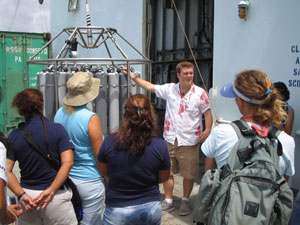|
Jan 12, 2006
Log by Trina Litchendorf

Roy's water taxi

Kathy and Jen climb aboard

Wes at open house

Kevin at open house

Nighttime CTD sampling
|
This morning we were picked up at our hotel and driven down to the docks where we loaded our luggage onto the Thompson’s Zodiac boat for the crew to take back to the ship. Then we hailed local “water taxis” to take us out to the ship. Once we reached the ship, the water taxis pulled up next the ship and we each had to climb up the Jacob’s ladder onto the ship. Onboard we picked up our luggage, got our cabin assignments and settled in. Then the students began unpacking the scientific equipment and getting the lab set up. Ecuadorian scientists, who will be conducting their research alongside of us, are joining us on this cruise. We are also being joined by Susan Adkins and her daughter Blakley who is a wildlife biology major at the University of Vermont. Susan is a member of ARCS (Achievement Rewards for College Student), which awards PhD students with scholarships. She was the top bidder in an auction sponsored by ARCS for two spaces on this cruise to raise funding and the money she bid helped offset the students travel expenses for this trip.
From noon to 3pm the ship hosted an open house for the scientists and staff of the Charles Darwin Research Station and the Galapagos National Park and Marine Reserve to come see the ship and hear about the research we are going to be conducting. Shortly before noon the visitors start arriving by water taxi and over 50 showed up. Both Wes and Kevin are fluent in Spanish so they served as official student ambassadors and led the groups on tours of the ship. I work at the University of Washington’s Applied Physics Laboratory and the scientist I work for has an instrument system onboard the Thompson called CIRIMS (Calibrated Infrared In situ Measurement System), which uses an infrared radiometer to measure the surface temperature in the top millimeter of the sea. I used the time while we were at anchor to service the instrument so I unfortunately don’t get to interact with the members of the tours groups. After the last of the tour groups left, Jonathan deployed a CTD cast and collected his samples while we were still in Academy Bay. When he finished the ship got underway at around 6pm.
On a research ship science is conducted around the clock. We are assigned our watches. I get the 12 to 4 watch, that is 12 noon to 4pm and 12 midnight to 4am. While on watch we are expected to help with the CTD and plankton net casts and any other operations. The CTD is an instrument system for collecting water samples from discrete depths. CTD stands for Conductivity (how salinity is measured), Temperature and Depth. It is a rosette of Niskin bottles that are opened on the top and bottom when the CTD is deployed. The CTD is lowered over the side of the ship and as it descends and it is monitored with a computer. The CTD additionally sends back information on chlorophyll concentrations, PAR (photosynthetically active radiation), transmissivity (how much particulate matter there is in the water) and pressure. When the CTD reaches the first water collection depth the operator simply clicks the mouse on the computer and the caps on either end of the Niskin bottles snap shut capturing a water sample from that depth, then the CTD is raised to the next water collection depth. Water samples collected with the CTD can then be analyzed for oxygen, nutrient, ammonia, and chlorophyll concentrations.
We reached my first collection site at around 1am, on my watch. After the CTD cast, I spent the next 4 and a half hours preparing my samples for my phytoplankton incubation experiment. It is nearly 6 am before I finally get to sleep.
|